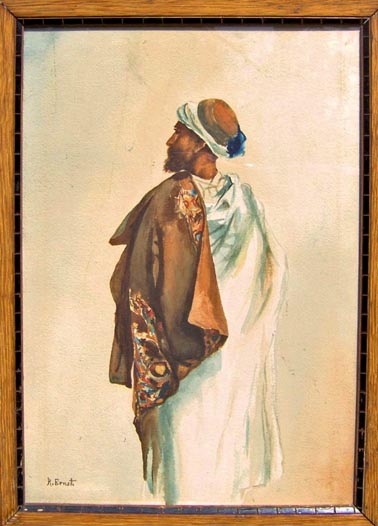

Orientalist Watercolor Painting: ca 1910
by Rudolf Ernst
A Short Biography of Rudolf Ernst
1854: Born in Vienna, the son of the architectural painter Leopold Ernst. 1869: Joined the Academy of Fine Arts in Vienna at the age of 15 1874: Traveled to Rome to study the representation of Italian landscapes and classical romantic figures prior to 1885 painting mainly portraits, images of children and genre scenes. 1885: Started to create Orientalist Paintings, paintings for which achieved great fame as an artist. 1885: Traveled through the Middle East, visiting Morocco, Spain and Turkey.The Favorite: 1872
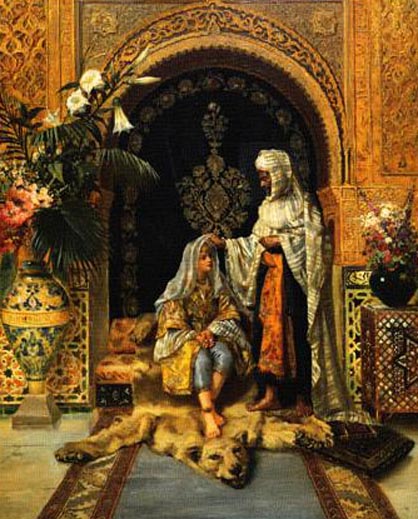
The Favorite
(Girl and a Man)
This depiction juxtaposes the man's power over the girl's powerlessness. Ernst has also drawn his subjects out of proportion to emphasize the power relationship. Note I also refer to them as 'girl' and 'man' because he has clearly painted them with a significant age difference - her face is youthful, fresh and bright, whereas he is tall and commanding.

Prayer in the Mosque

Smoking the Hookah

Return from the Tiger Hunt
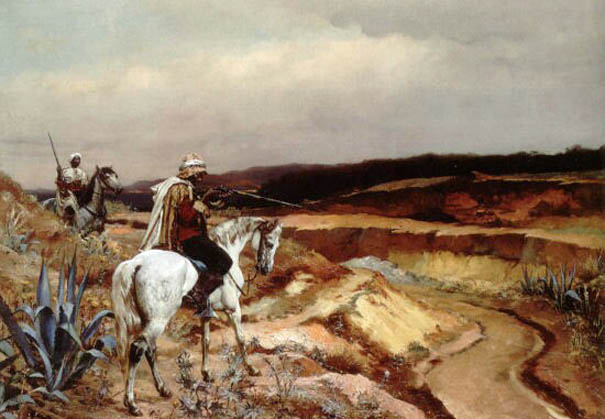
The Tiger Hunt
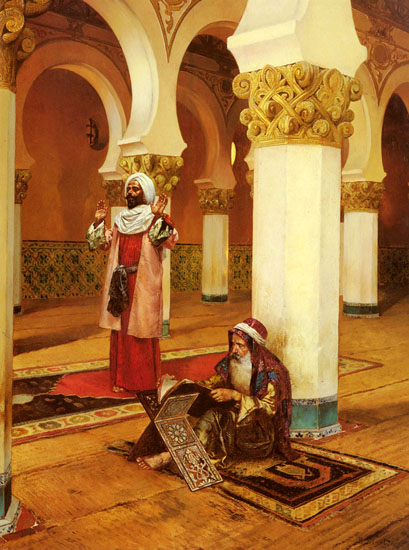
Evening Prayer
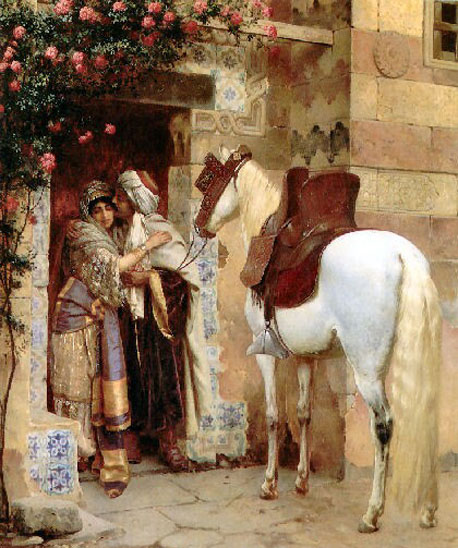
The Lovers
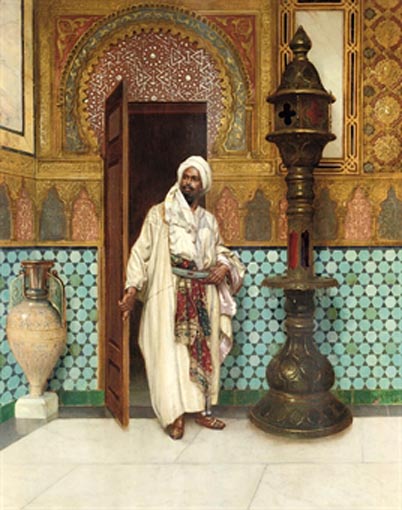
An Elegant Chieftain in his Palace
His exceptional mastery lies in his ability to combine layers of genuine artifacts in order to create outstanding fantasy. For instance, details like the 18th Century Ottoman sash tied around the Chieftain's waist juxtaposed with blue and green Moroccan tiles exemplify Ernst's skill in visually cross-referencing the archetypal designs of various regions in order to enhance his compositions. In 'An Elegant Chieftain in his Palace', Ernst decorates a regal Hispano-Moresque palace interior based on the Alhambra with objects most likely included in his own personal collection (as they were repeatedly included in his Orientalist compositions).
Similar to Lewis and Gerome, Ernst gathered a sizeable group of artifacts from his travels to the Middle East such as tiles, lamps, pottery, silks, satins and kaftans. The 17th Century Persian blue and white pot, for example, was also depicted in 'Un ciseleur' and in 'Outside the Selim Tribe', 'Constantinople', as well as in 'The Perfume Makers'. Furthermore, the 19th Century Syrian bronze lamp to the right of the Chieftain was depicted in 'After the Prayer' and in 'The Wedding Day'. The red and gold embroidered silk Damask curtain was also used in 'Smoking the Hookah', and the Moorish octagonal blue and green tiles were illustrated in 'Reading the Koran'. The 19th Century Syrian mother-of-pearl inlaid table placed to the Chieftain's left is also depicted in the Refreshment (Najd Collection). T he Alhambra-style background is a favorite setting that Ernst repeatedly returned to in his ambitious compositions such as 'The Wedding Day' as well as 'The Moorish Guard', 'The Alhambra'.

The Arab Prince
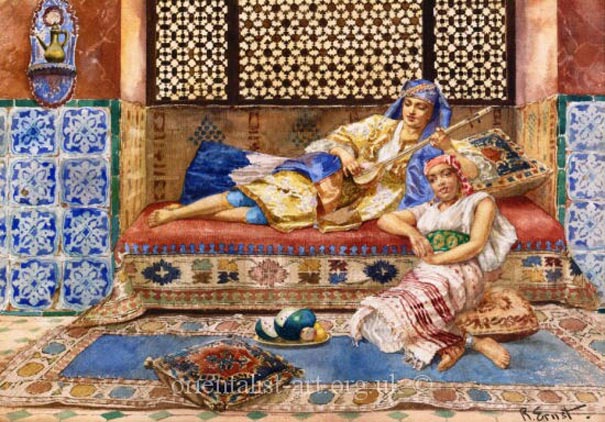
Harem Girls

The Pasha's Favorite Tiger
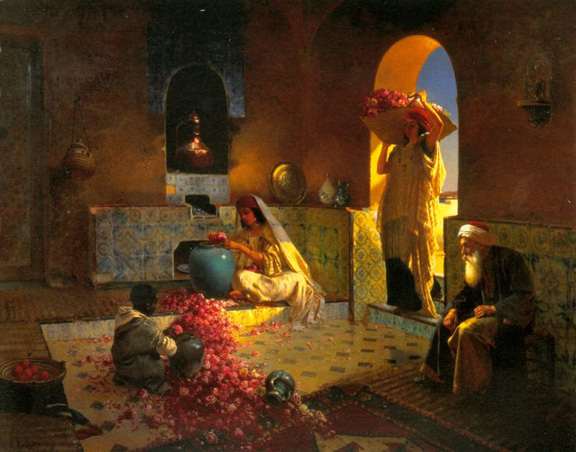
The Perfume Makers
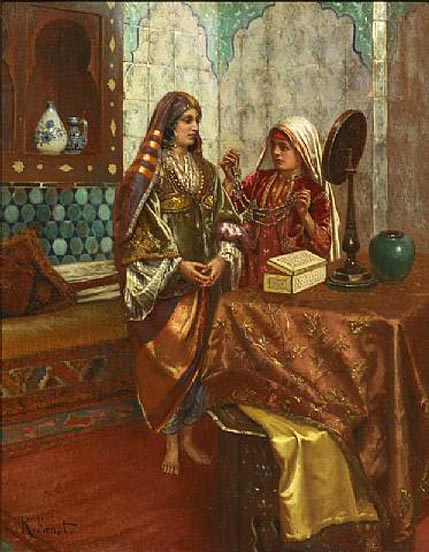
The Wedding Gift
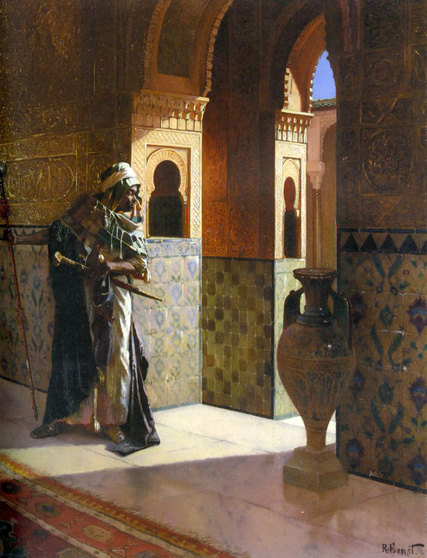
The Moorish Guard
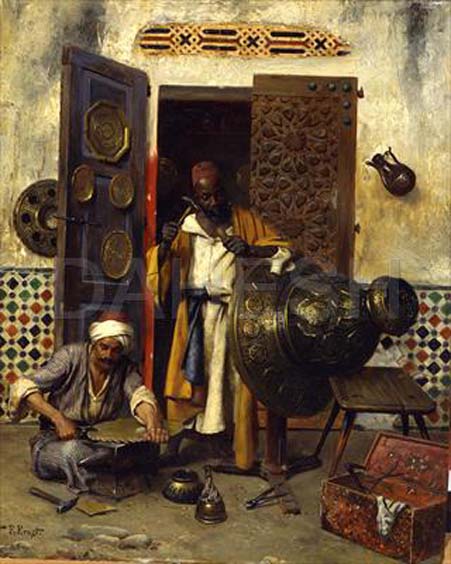
The Metal Workers
A devoted Orientalist, Ernst concentrated almost exclusively on mosque and harem interiors, as well as other scenes of daily life in North Africa and the Middle East. He based his paintings on photographs and prints, as well as on his own memories and sketches of Morocco and Constantinople (present-day Istanbul), frequently relying upon favorite patterns or objects. Unlike some of his peers, whose approach to these subjects was strictly topographical or ethnographic, Ernst often blended the architecture, artifacts, and costumes of diverse cultures. His intensely detailed images glow with jewel-like color and are energized by the complex interplay of rich fabrics, decorative tiles, and intricate metalwork.

The Lesson
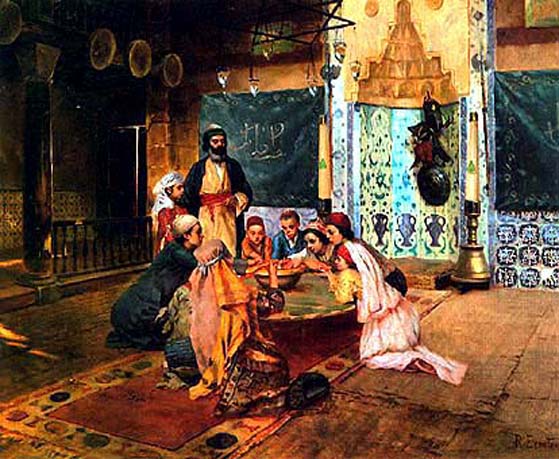
The Meal
A Venetian living in France, in 1885 Rudolph Ernst began to travel extensively throughout the Middle East. For the next decade he visited Morocco, Spain and Turkey. His work appealed to eastern tastes more strongly than western. Although he exhibited for decades in Paris the critics ignored his work. More importantly however his work was appreciated by the very people whose images he painted. While in Turkey he received several important commissions from the minister Agop Pasha.
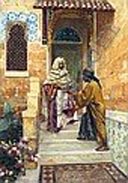
The Presentation
(I know that this depiction of The Presentation is small and not very clear, I spent a good amount of time searching and this was the best I could find. Mea Culpa
Senex Magister
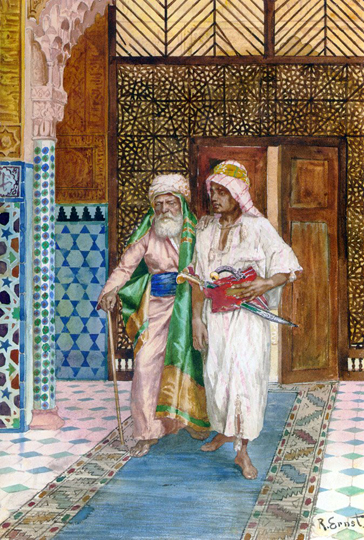
Returning Home
(Pencil Watercolor on Paper)

Romantic Interlude
Although Rudolf Ernst traveled several times to North Africa and Spain, harem scenes as this one would be completely painted from imagination. Access to harems was not granted to foreigners and scenes such as this would have never been witnessed by them. It is known though that Ernst did bring home props from his travels and that he decorated his Paris studio with them. On a side note Ernst even wore a taboosh, while painting, to feel more in an 'Eastern' mood.
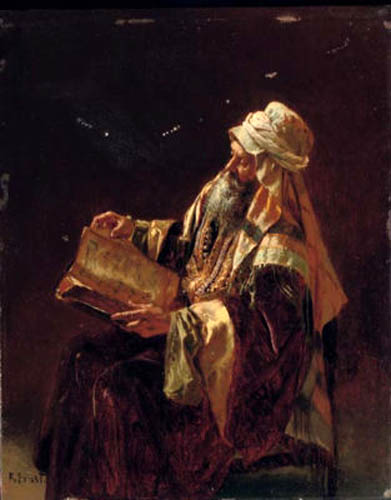
The Scholar
Reminiscent of Rembrandt's work, Rudolf Ernst has changed to a much more muted palette in this painting. He has used chiaroscuro to model the figure and applied a strong directional light to illuminate the figure.

Portrait of an Arab Nobleman
Ernst is best known for his Orientalist pictures which portray merchants, guards and pashas of the Ottoman Empire. He did paint a small number of portraits, which were commissioned during his travels in Turkey in 1890.
Noteworthy too are a series of pictures of Arab sentinels and other protectors, which feature elaborately costumed male figures standing guard at entrances to marble palaces, harems, and other sacrosanct spaces. Though the entire Austrian School of Orientalist seems to have had a fascination for such scenes, it was Ernst (and his friend Deutsch) who virtually monopolized the field and captured the public's attention. Indeed, even so popular a painter as Jean-Léon Gérôme could not compete with Ernst's barrage of textures and surfaces, and thanks to the liberal use of photographs, his exquisitely rendered and highly informative records of specific weapons and garments.
Though it can be considered a variation on the sentinel theme, the present picture is remarkable in Ernst's oeuvre - and not merely because of its size, which makes it one of Ernst's largest painted canvases. The bearded sitter has long been believed to be the Algerian leader and Arab folk hero Abd el Kadir (1808-1883), a figure well known to European audiences by the middle of the nineteenth century. Abd el Kadir's absolute resistance of foreign domination, driven in the name of his Islamic faith, had become a matter of international interest. In 1845, Horace Vernet (1780-1863) had exhibited his extraordinary 'The Taking of the Smalah of Abd el Kadir', a picture commissioned by the King in order to both reflect France's agenda of total conquest and to justify its continued outlay of revenue in Algeria. More specifically, and as the exhaustive livret described, the panoramic work depicts the surrender of Abd el Kadir to the Duke of Aumale, the son of Louis-Philippe, and 600 of his French horsemen. Of the 5000 Algerians who took part in the battle, 300 were killed and 3000 taken prisoner, including el Kadir himself.
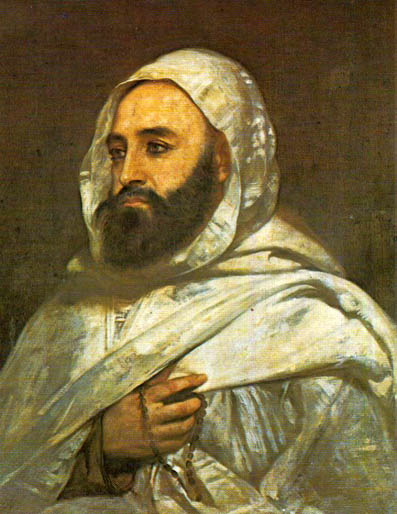
Abd al-Qadir by Ange Tissier-1852
After a period of imprisonment in France between 1847-1852, Abd el Kadir relocated to Damascus. There, in 1860, he was credited with saving the lives of an estimated 12,000 Christians, including the French consul and his staff, during a massacre instigated by local Ottoman officials. In an ironic historical twist, the French government conferred on their former nemesis the Grand Cordon of the Legion of Honour, and additional honors followed from a number of other European governments. Historical accounts remember Abd el Kadir first for his military exploits, but also for his immaculate white burnous, his friendship with many prominent European travelers, most notably Isabeland Richard Burton, and for his later poetry and scholarly and theological pursuits.
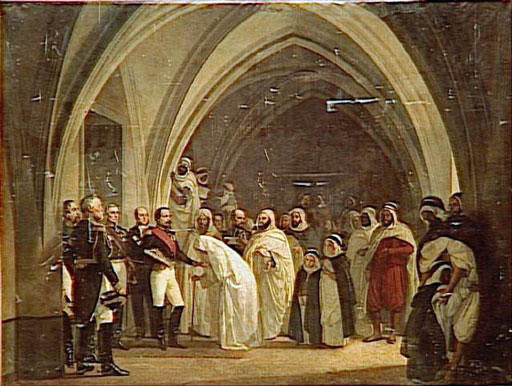
Napoleon III granting Alb de Kader his freedom: October 16, 1852
Artist Unknown, at least to me - Senex Magister
With the end of Abd el Kadir's self-proclaimed holy war against France in 1843, artists began to travel more frequently to Algeria. (Eugène Fromentin may be considered the first major European artist to venture to the region for an extended period of time.) While there is no record of a meeting between Abd el Kadir and Ernst, certain details of the artist's work seem to dovetail with this celebrated figure. The placement of the man's hand on the sword, for example, recalls Abd el Kadir's military accomplishments, while the open text below suggests his famed religious fervor. Ernst's care in choosing a startlingly white paint to render the man's robes, moreover, might be meant as a reminder of Abd el Kadir's distinctive dress. And certainly, compelling comparisons can be made between this bearded visage and that portrayed in other contemporary visual documents. But there are other details, as well, which suggest a far different interpretation: the ornate faience tiles in the background point to Ernst's own interests at the time, and the carved Koran stand, set among other exotic still life objects, is a motif that reappears in others of his paintings. Indeed, and despite the intriguing attribution regarding the identity of the sitter, this painting might be read as a reflection of Ernst's own career, and a cumulative memory of disparate Middle-Eastern travels.
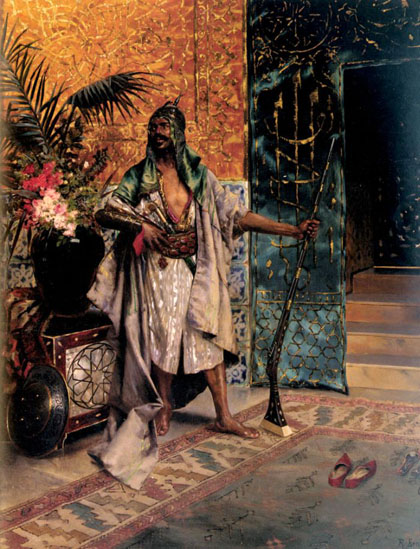
Harem Guard
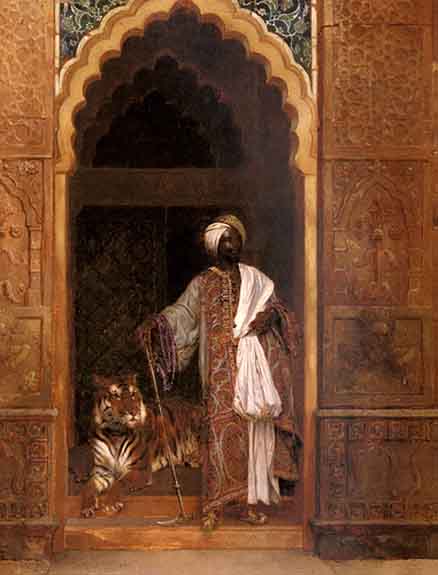
A Sultan with a Tiger
A Sultan with a Tiger is one of several paintings loosely inspired by India (a country Ernst never visited), in which the artist reveals the extent to which he indulged his own and his audience's imaginations. It combines textiles from Europe and Asia, sculpture from India, tiles from North Africa, a modern Cairo-ware lamp, with a Nubian figure in Islamic dress. Typically, the picture includes just a single, exotically dressed figure, who is given added drama not only by the tiger, but also by Ernst's favorite compositional technique of depicting his subjects from a low perspective, heightening their grandeur and presence.
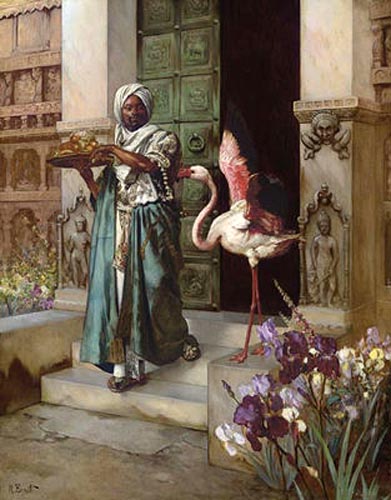
Entering the Palace Gardens
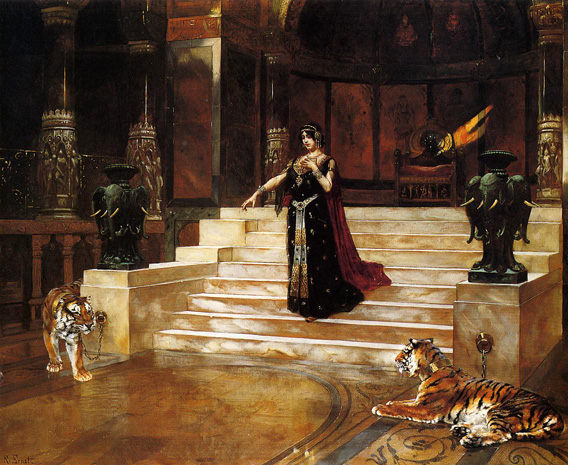
Salome and the Tigers
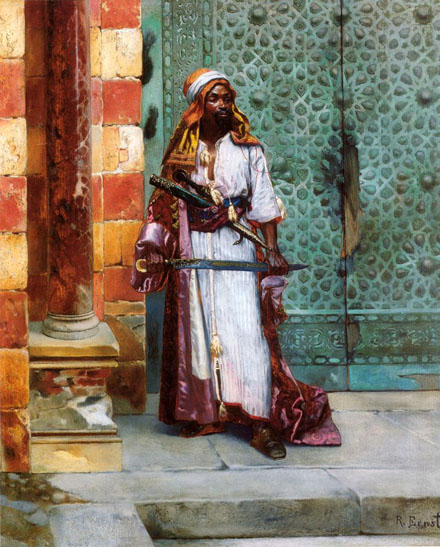
Standing Guard
More of Rudolph Ernst
Sortie de la marie
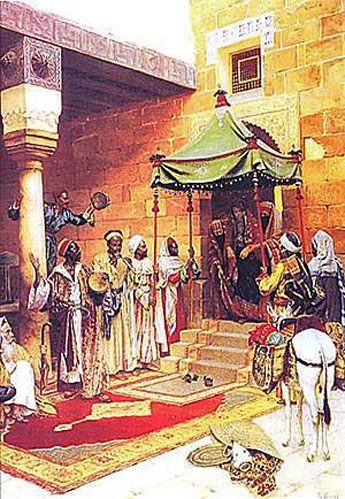
Sortie de la mariée
'On the night of the wedding ceremony, the rapt attention focused upon me, especially by my friends, increased my joy so that I almost leapt with delight while I donned my wedding dress embroidered in thread of silver and gold. I was spellbound by the diamonds and other brilliant jewels that crowned my head and sparkled on my bodice and arms... Suddenly a commotion erupted outside the great hall. The dancer rushed out emitting a string of zaghrudas, the tremulous trills hanging in the air after her...' - Huda Sha'rawi
The Chess Game
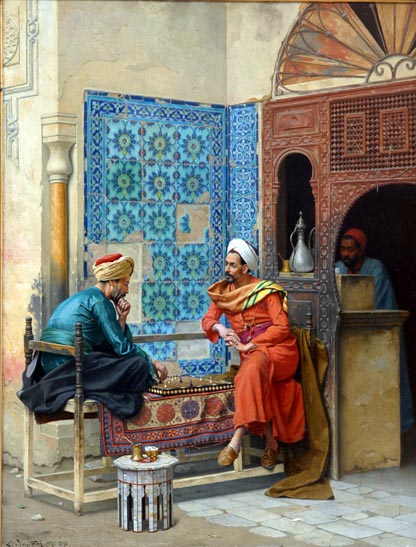
The Chess Game
Little is known about Deutsch's life. He was a perfectionist and a discreet man who did not often appear in public. He had a close friendship with Rudolf Ernst, with whom he shared his passion for Orientalist painting. He settled in Paris and eventually became a French citizen. Deutsch painted scenes of ordinary and religious life, demonstrating tremendous skills in his representations of human expressions and gestures, the subtleties of clothing, and the beauty of Islamic architecture and decoration. He also used professional photographs of settings as a basis for his artwork. His compositions appear natural and at the same time sophisticated, with an exotic and romantic touch.
La Manucure
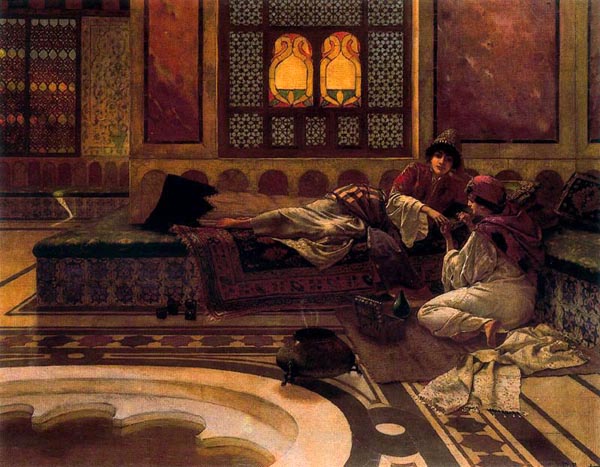
La Manucure
Renowned German Orientalist Rudolf Ernst exhibited his work regularly in Paris, including "The Manicure." Like many Orientalist interiors, Ernst's evoke both realistic domesticity and mild voyeurism.
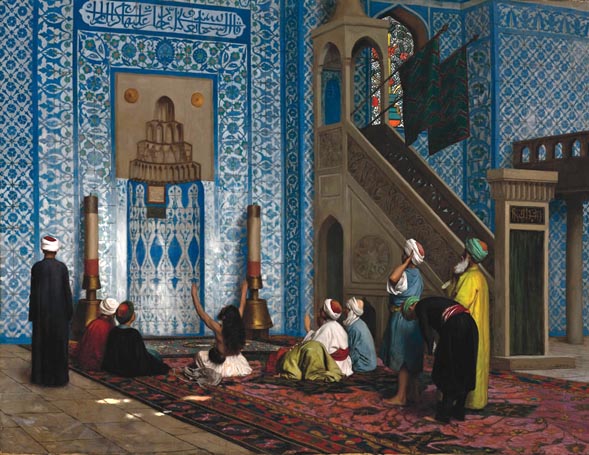
The Shafik Gabr
Jean-Léon Gérôme has often been accused of voyeurism, too, which restricts the modern popularity of his work: "Rustem Pasha Mosque" is more accurate architecturally than in its casual depiction of Islam.
Other Examples of 'The Manicure
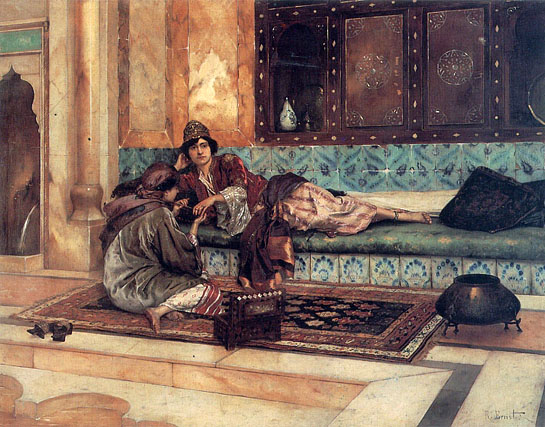
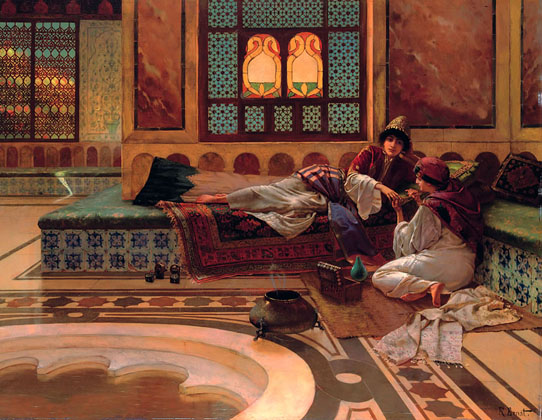
The Letter: 1888
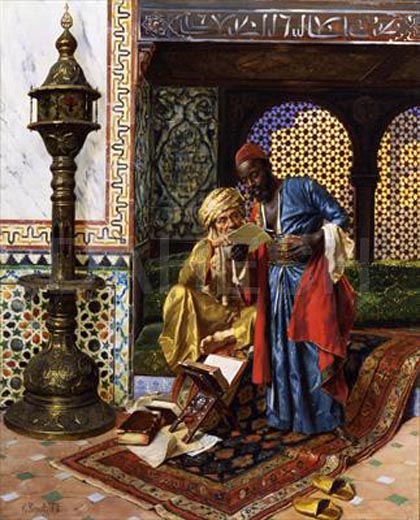
The Letter: 1888
In an attempt to create skillfully painted exotic images for a Western audience, Ernst did not hesitate to blend the architecture, artifacts, and costumes of diverse cultures. In this painting, the Arabic script on the wooden beam over the two figures may look authentic, but it not only incorrectly copies the common phrase "There is no victor but God," it is also painted in reverse.
A Moorish Interior
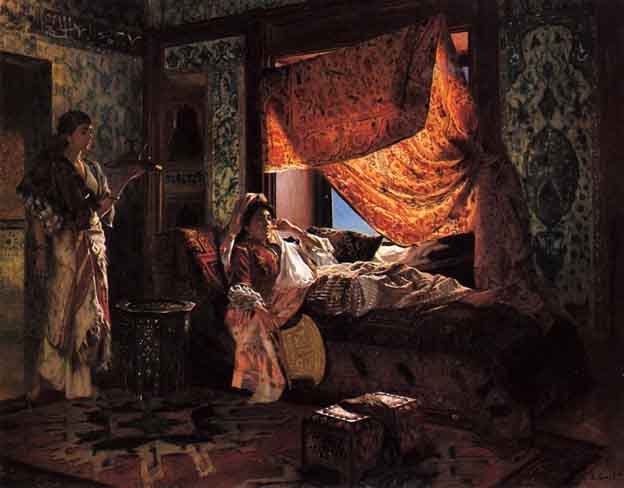
After Prayer
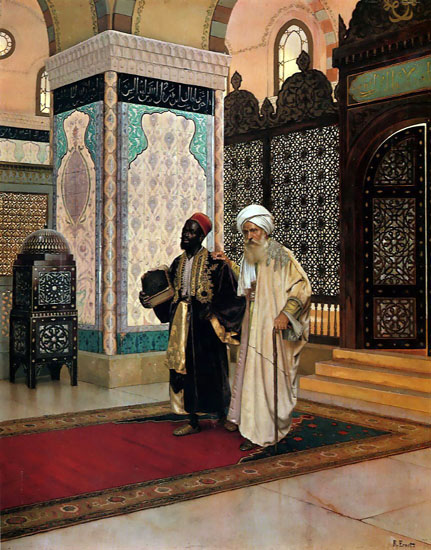
An Afternoon Show
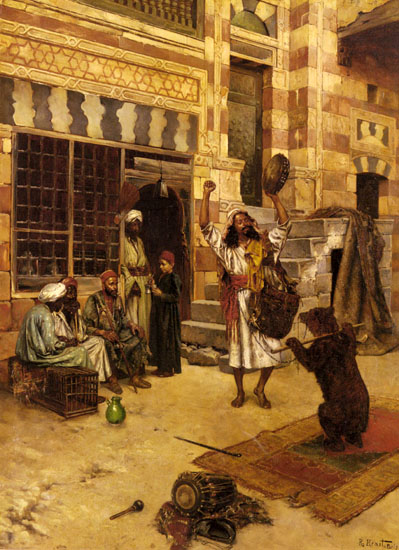
An Arab Sage

Awaiting the Tiger
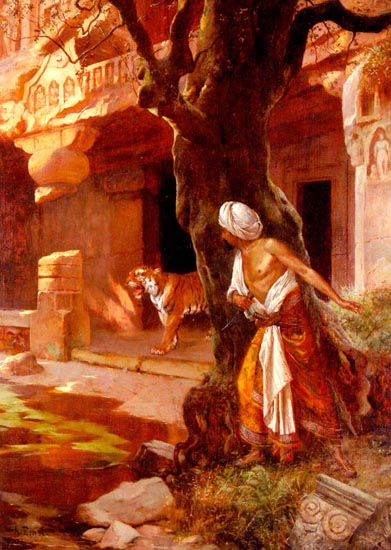
By the Entrance
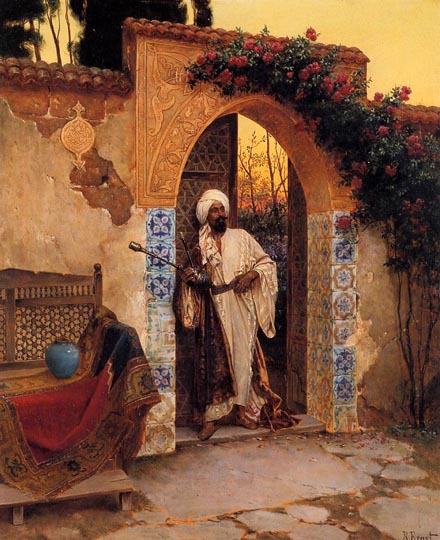
Elegant Arab Ladies on a Terrace at Sunset
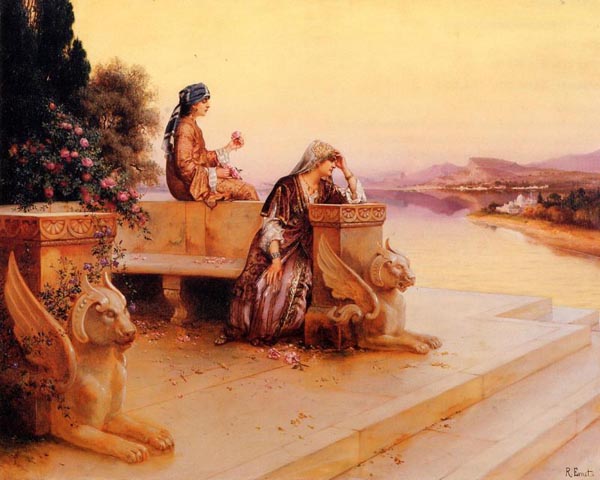
Gnaoua in a North African Interior
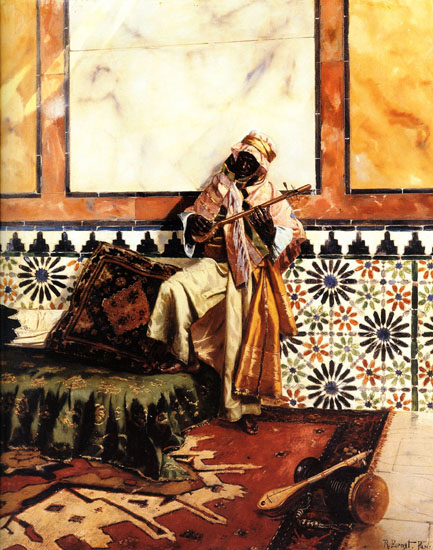
In the Alhambra: 1888
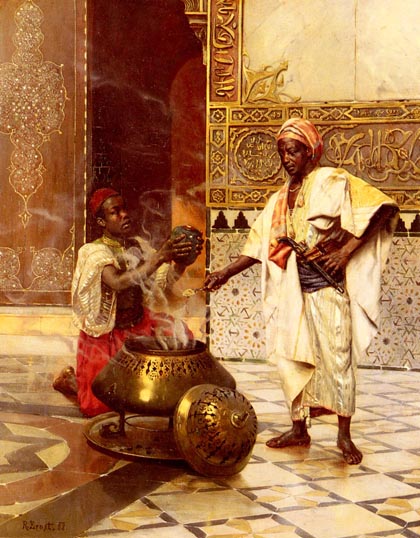
In the Dressing Room

Keeping the Books
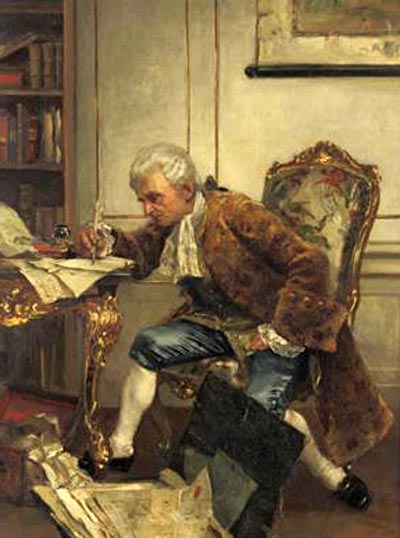
Le Marchand De Fleurs
(The Flower Merchant)
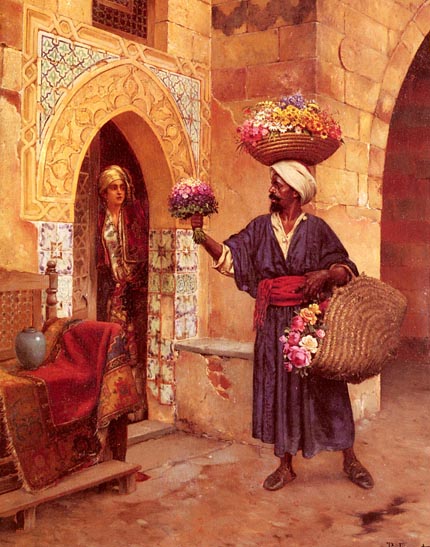
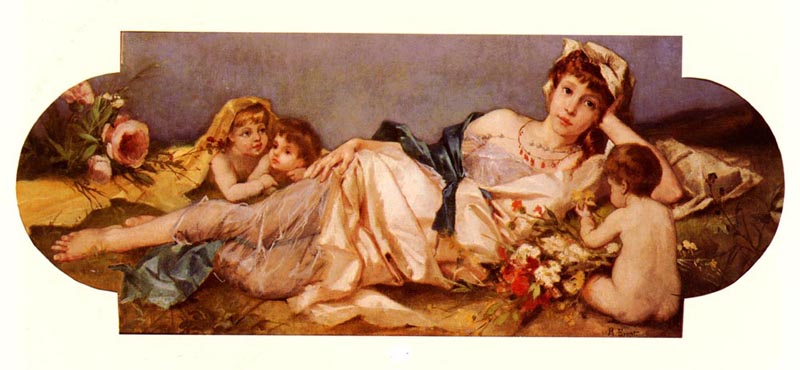
Outside the Selim Tabe, Constantinople
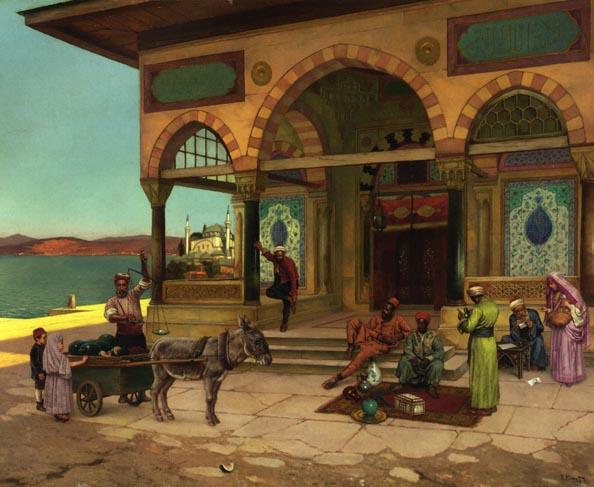
Preparing the Hookah
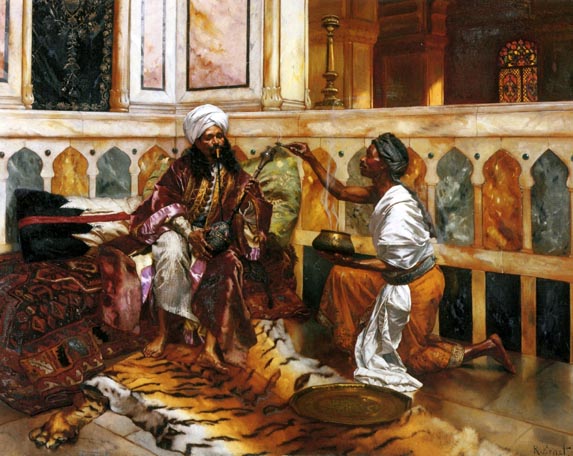
Reading a Book

Spinning Yarn in the Harem

The Beggar
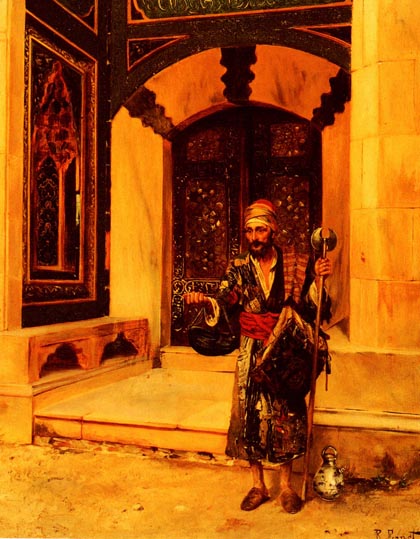
The Captives
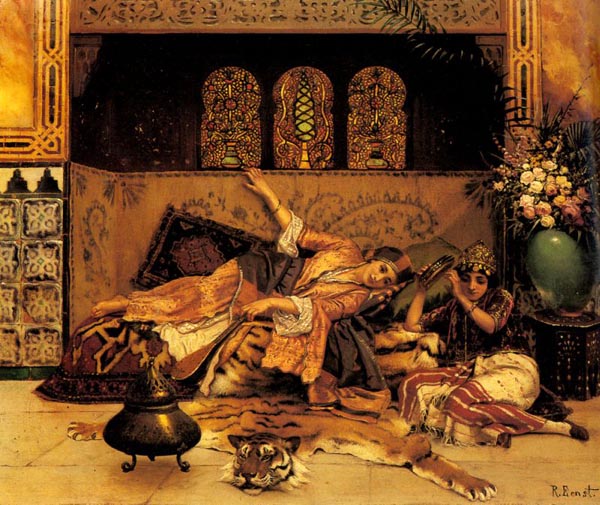
The Guard of the Harem

The Hammam
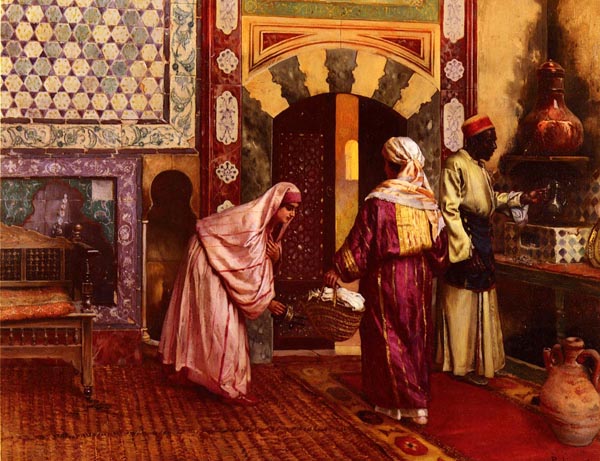
The Harem Bath
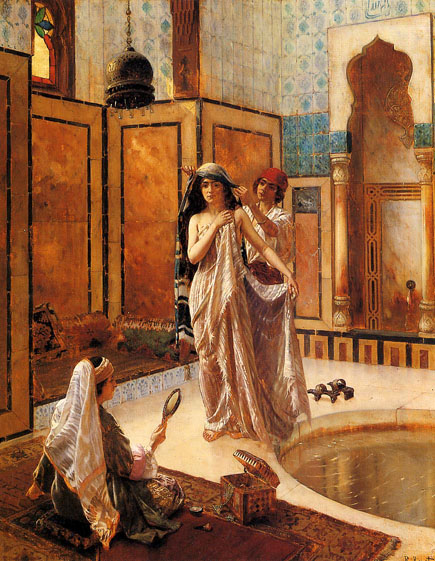
The Hookah Smoker

The Jewelery Box
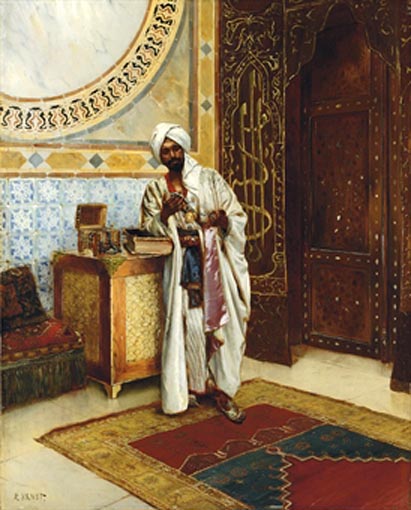
The Money Changer

The Musician
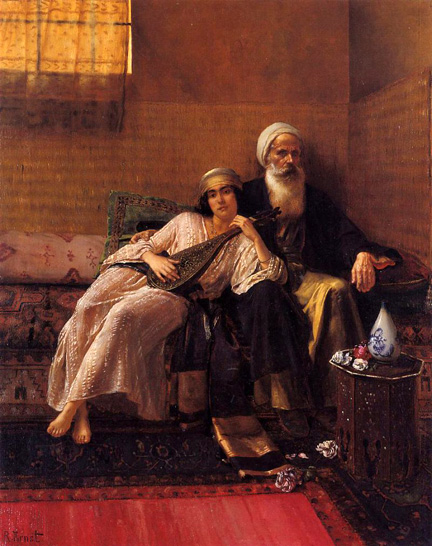
The Orange Seller
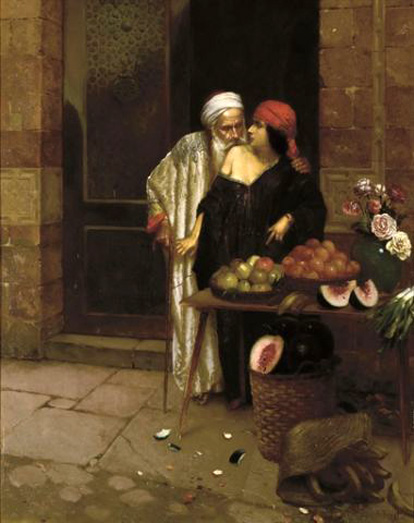
The Reader
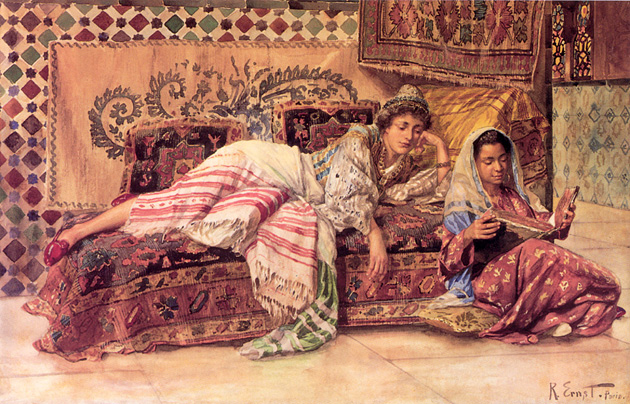
The Reader

The Rug Merchant

The Staircase under the Trees
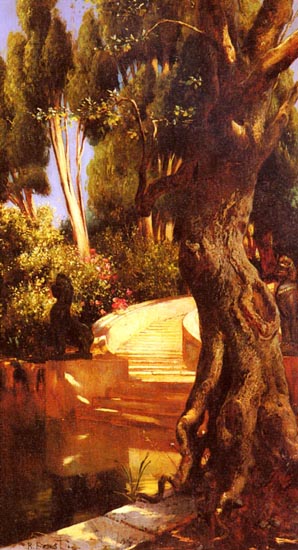
The Terrace

he Wedding Gift

Young Ladies on a Terrace in Tangiers
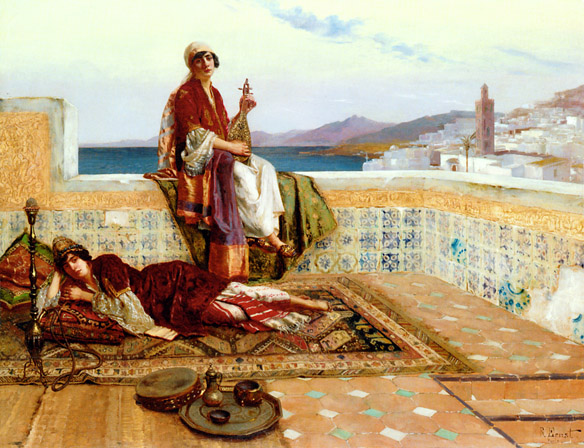
Rustem Pasha Mosque, Istanbul
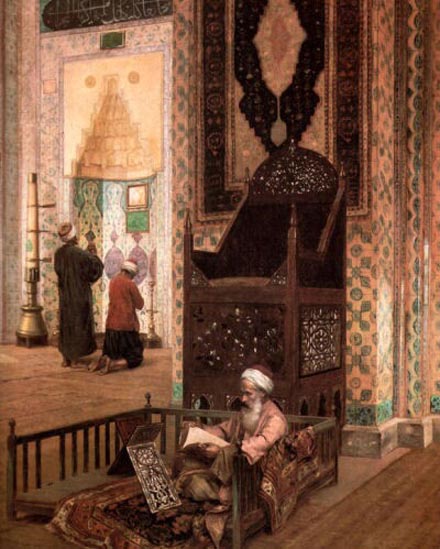
Tambourine Still Life
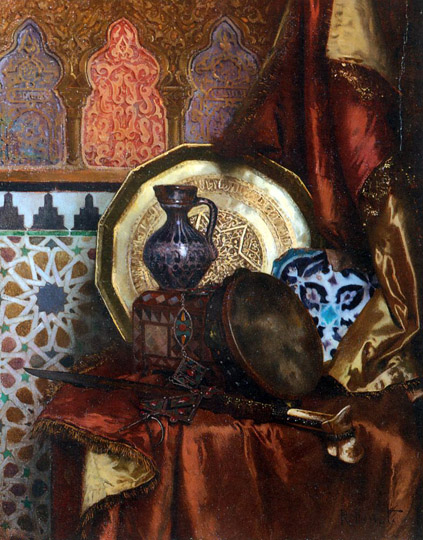
Return to Pagina Artis
Return to Bruce and Bobbie's Main Page.